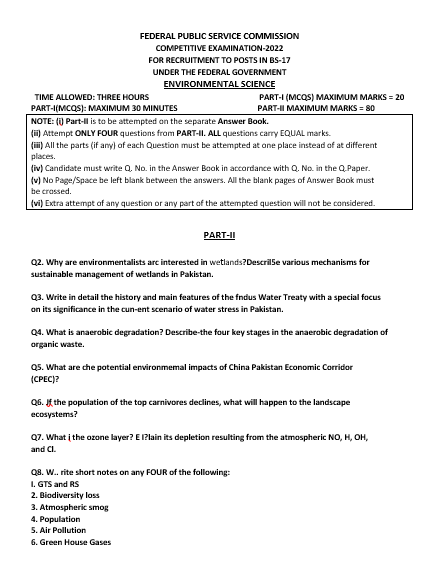Table of Contents
ToggleCSS Environmental Science Paper 2022
Q2. Why are environmentalists interested in wetlands?Descril5e various mechanisms for sustainable management of wetlands in Pakistan.
Q3. Write in detail the history and main features of the Indus Water Treaty with a special focus on its significance in the current scenario of water stress in Pakistan.
Q4. What is anaerobic degradation? Describe the four key stages in the anaerobic degradation of organic waste.
Q5. What are the potential environmental impacts of China Pakistan Economic Corridor (CPEC)?
Q6. If the population of the top carnivores declines, what will happen to the landscape ecosystems?
Q7. What is the ozone layer? Explain its depletion resulting from the atmospheric NO, H, OH, and Cl.
Q8. Write short notes on any FOUR of the following:
- GTS and RS
- Biodiversity loss
- Atmospheric smog
- Population
- Air Pollution
- Green House Gases
Read Related Article
CSS Environmental Science Paper 2016
CSS Environmental Science Paper 2017
CSS Environmental Science Paper 2018
CSS Environmental Science Paper 2019
CSS Environmental Science Paper 2020
CSS Environmental Science Paper 2021
Environmental Sciences Past Paper 2023
Environmental Sciences Past Paper 2024
Summary of Questions:
Q2. Why are environmentalists interested in wetlands? Describe various mechanisms for sustainable management of wetlands in Pakistan.
Environmentalists focus on wetlands because they are vital ecosystems that support biodiversity, improve water quality, and provide services like flood control and carbon storage. In Pakistan, sustainable management mechanisms include conserving wetland areas through legal protections, promoting community involvement in wetland preservation, restoring degraded wetlands, and managing water resources to maintain wetland health.
Q3. Write in detail the history and main features of the Indus Water Treaty with a special focus on its significance in the current scenario of water stress in Pakistan.
The Indus Water Treaty, signed in 1960 between India and Pakistan, regulates the sharing of water from the Indus River system. It allocates water rights for the Beas, Ravi, and Sutlej rivers to India and the Indus, Jhelum, and Chenab rivers to Pakistan. The treaty remains critical today due to increasing water stress in Pakistan, where efficient management and protection of water resources are necessary for agricultural and drinking water needs.
Q4. What is anaerobic degradation? Describe the four key stages in the anaerobic degradation of organic waste.
Anaerobic degradation is the process where organic waste breaks down without oxygen, often in landfills or digesters. The four stages are: 1) Hydrolysis, where complex organic materials are broken down into simpler compounds, 2) Acidogenesis, producing acids and gases, 3) Acetogenesis, where acids are converted to acetic acid, and 4) Methanogenesis, where methane is produced by microorganisms, completing the degradation process.
Q5. What are the potential environmental impacts of China Pakistan Economic Corridor (CPEC)?
The China-Pakistan Economic Corridor (CPEC) may have several environmental impacts, such as deforestation, habitat loss, pollution from construction activities, and increased carbon emissions due to infrastructure development. However, it also has the potential to improve energy efficiency and promote sustainable practices if managed carefully.
Q6. If the population of the top carnivores declines, what will happen to the landscape ecosystems?
If top carnivores decline, ecosystems can experience significant imbalances. The decline can lead to an increase in herbivore populations, resulting in overgrazing and degradation of vegetation. This disrupts plant communities and affects the overall health of the landscape, leading to biodiversity loss and ecosystem instability.
Q7. What is the ozone layer? Explain its depletion resulting from the atmospheric NO, H, OH, and Cl.
The ozone layer is a layer of ozone (O₃) molecules in the Earth’s stratosphere that protects life by absorbing harmful ultraviolet (UV) radiation. Ozone depletion occurs when chemicals like nitrogen oxides (NO), hydrogen (H), hydroxyl (OH), and chlorine (Cl) break down ozone molecules, thinning the ozone layer and allowing more UV radiation to reach the Earth’s surface, increasing health risks and environmental damage.
Q8. Write short notes on any FOUR of the following:
- GTS and RS: Geographic and Remote Sensing (GTS and RS) involve the use of satellite imagery and data to monitor and analyze Earth’s surface, assisting in environmental management, disaster response, and resource planning.
- Biodiversity loss: Biodiversity loss refers to the decline or extinction of species and ecosystems, often due to human activities like habitat destruction, pollution, and climate change.
- Atmospheric smog: Smog is a type of air pollution that forms when smoke and fog combine, often exacerbated by vehicle emissions and industrial pollutants, leading to health problems and environmental degradation.
- Population: Population refers to the number of individuals in a given area. Population growth, especially in urban areas, can strain resources, cause environmental damage, and increase pollution.
- Air Pollution: Air pollution involves harmful substances, like carbon monoxide, sulfur dioxide, and particulate matter, entering the atmosphere, leading to respiratory diseases, climate change, and ecosystem damage.
- Greenhouse Gases: Greenhouse gases, such as carbon dioxide, methane, and nitrous oxide, trap heat in the Earth’s atmosphere, contributing to global warming and climate change.
